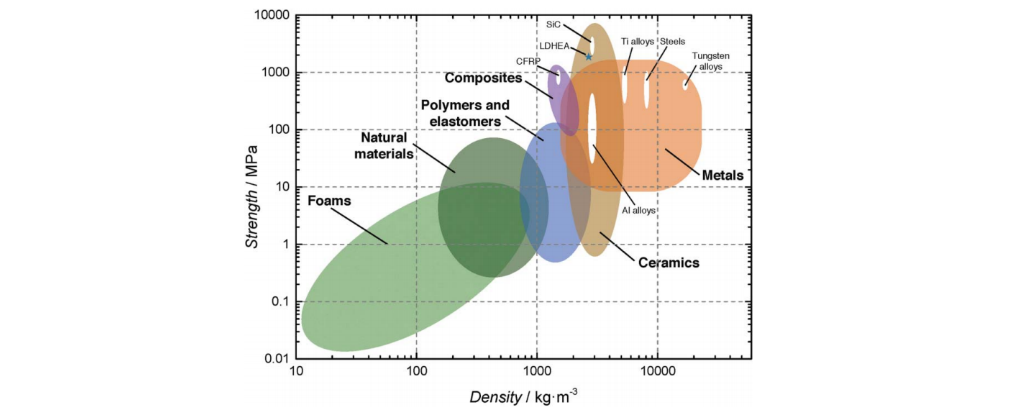Selecting the right material is crucial in every engineering project. Among various material properties, the strength-to-weight ratio is one of the most important. It directly impacts product performance, Riduzione del peso, and overall design efficiency.
In questo articolo, we’ll explain what strength-to-weight ratio is, factors affecting it, and its practical applications across different industries.
What is Strength-to-Weight Ratio?
The strength-to-weight ratio sounds like a complicated term, but it’s actually pretty simple once you break it down.
It’s all about how strong something is rispetto a how heavy it is.
In other words — how much strength do you get for every pound (or kilogram) of weight?
This ratio helps engineers figure out which materials can handle a lot of force without being too heavy. It’s super important for products like airplanes, automobili, robots, or even sports equipment — anything where you want things to be both strong and light.
Think About It Like This:
A piece of steel is really strong — but it’s also really heavy.
A piece of plastic is super light — but it’s not very strong.
The best materials for certain jobs are the ones that have Entrambi strength and low weight.
That’s where the strength-to-weight ratio comes in. It tells you which materials give you the best mix of both.
Why is Strength-to-Weight Ratio So Important in Engineering?
When engineers design a product — whether it’s a car, airplane, bridge, or even a bicycle — they’re always trying to find the best balance between strength and weight.
If something is strong but too heavy, it can slow things down, waste energy, or cost more to build and transport. D'altra parte, if it’s super light but not strong enough, it could break easily or become unsafe.
That’s why the strength-to-weight ratio matters so much. It helps engineers choose materials that are both tough E light — giving them the best of both worlds.
Here’s Why It Really Matters:
Save Weight, Save Energy
In industries like aerospace and automotive, lighter materials mean better fuel efficiency. A lighter car or plane uses less energy to move — which is better for both performance and the environment.
Strong Enough to Stay Safe
Even when reducing weight, safety comes first. Materials with a high strength-to-weight ratio help build products that stay strong and stable without adding extra bulk.
Save Costs on Materials
Using stronger, lighter materials means you can often use less material overall — which helps cut costs in production and shipping.
Prestazioni migliori
Whether it’s a sports car, a drone, or a racing bike — reducing weight while keeping strength gives better speed, control, e durata.
More Design Flexibility
Lighter materials allow engineers to get creative with design — making products that are smaller, Più veloce, or more innovative without sacrificing quality.
What Things Affect Strength-to-Weight Ratio? (It’s Not Just About the Material!)
It’s not as simple as just picking the lightest or strongest material — there are a few things that can change how good (or bad) a material’s strength-to-weight ratio really is.
Here are some of the biggest factors:
The Type of Material
Different materials naturally have different strength-to-weight ratios.
Metals like steel, alluminio, or titanium are strong, but they all have different weights.
Carbon fiber is super light and really strong — that’s why it’s popular for planes, bikes, and race cars.
Plastics are very light, but usually not very strong (unless mixed with other materials).
| Materiale | Rapporto resistenza-peso | Caratteristiche |
| Titanio | Molto alto | Leggero, resistente alla corrosione |
| Lega di alluminio | Alto | Leggero, versatile strength |
| Fibra di carbonio | Molto alto | Excellent tensile strength, low weight |
| Acciaio | Moderare | Strong but heavy |
| Plastica | Low to Moderate | Leggero, less durable |
| Legna | Moderare | Leggero, sensitive to moisture |
The Shape or Design
Believe it or not, the shape of a part or product can also make a big difference.
Sometimes a smart design — like hollow parts or special patterns — can make something stronger senza adding more weight.
Esempio: Think of a bridge with a lot of triangle shapes — that’s done on purpose because it makes the structure stronger while using less material.
Material Treatment or Processing
Materials can also be treated in special ways to boost their strength-to-weight ratio.
Heat treating metal can make it stronger.
Adding coatings or mixing materials (like carbon fiber with resin) can improve durability without adding much weight.
The Environment
Where and how the material is used also matters.
Some materials are strong but won’t do well in very hot, cold, or wet conditions. Engineers have to think about:
Will it rust?
Will it crack in freezing weather?
Will sunlight weaken it?
Common Applications of High Strength-to-Weight Ratio Materials
Materials with high strength-to-weight ratios are widely used in many industries.
Industria aerospaziale
Aereo, spaziale, and satellites require materials that offer maximum strength with minimum weight for fuel efficiency and structural integrity.
Related Reading: Top Materials Used in Aerospace CNC Machining
Industria automobilistica
Lightweight materials improve vehicle performance, fuel efficiency, and meet emission regulations without compromising safety.
Civil & Structural Engineering
Ponti, torri, and buildings use materials with good strength-to-weight ratios to handle loads while reducing structural mass.
Attrezzatura sportiva
Carbon fiber and titanium are popular in bicycles, caschi, and sports gear for their lightweight and durable properties.
Robotica & Elettronica
Light materials enable better movement, reduced energy consumption, and increased battery life for robots and drones.
Why Partner with a CNC Machining Expert?
Choosing the right material is only part of the solution. Partnering with an experienced CNC machining manufacturer ensures that the materials selected meet project requirements while staying cost-effective and easy to manufacture.
Recommended Partner:
Massima precisione, we specialize in CNC machining services for a variety of industries. Our experts can help you select the optimal material based on your project’s strength-to-weight ratio requirements.
Explore Our Services: CNC Machining Services by Tops Precision
Conclusione
Understanding the strength-to-weight ratio is essential for modern engineering projects. It allows for innovative designs that are lightweight, durevole, and energy-efficient. By selecting the right materials and manufacturing partners, engineers can create products that meet both performance demands and budget requirements.
Domande frequenti (Domande frequenti)
1. What is a good strength-to-weight ratio for engineering materials?
A good strength-to-weight ratio depends on the application. Materials like carbon fiber, titanio, and aluminum alloys offer excellent strength-to-weight performance for industries such as aerospace, settore automobilistico, and sports equipment.
2. Why is strength-to-weight ratio important in product design?
Strength-to-weight ratio is crucial because it helps engineers create products that are both strong and lightweight. This leads to better energy efficiency, improved safety, Costi materiali inferiori, and greater design flexibility.
3. Which materials have the highest strength-to-weight ratio?
Materials with the highest strength-to-weight ratios include carbon fiber, leghe di titanio, and advanced composites. These materials are commonly used in aerospace, automotive racing, and high-performance sports equipment.
4. How do engineers improve the strength-to-weight ratio of a product?
Engineers can improve strength-to-weight ratio by selecting advanced materials, optimizing the product design (like using hollow structures or support patterns), and applying material treatments like heat treatment or composite layering.
5. What industries benefit most from high strength-to-weight ratio materials?
Industrie come Aerospace, settore automobilistico, civil engineering, robotica, and sports equipment manufacturing benefit greatly from materials with high strength-to-weight ratios due to the need for lightweight and durable components.
Recommended External Links for SEO (Fonti autorevoli)
https://www.sciencedirect.com/topics/engineering/strength-to-weight-ratio
https://www.materialstoday.com/composite-applications/features/importance-strength-weight-ratio/
https://www.engineering.com/story/why-strength-to-weight-ratio-is-crucial-in-modern-engineering
https://www.azom.com/article.aspx?ArticleID=21548 (AZoM – Materials Science)






1 pensato a “Rapporto resistenza-peso in ingegneria: Definizione, Fattori & Applicazioni”